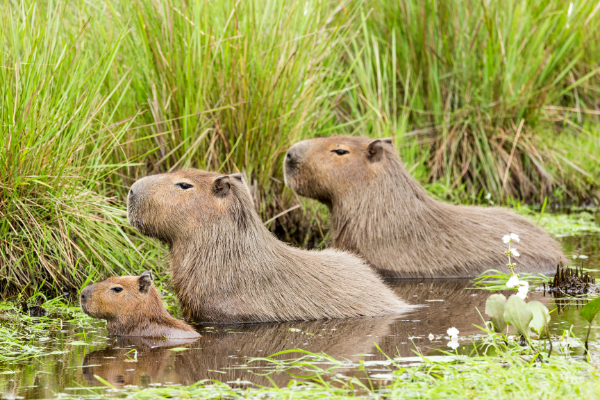ARGENTINA
World’s Largest Rodent
By Chadd McGlone
Chapel Hill, NC, United States
Take a hippopotamus, shrink it, add shaggy, brown hair, and remove its tail. What do you get? A capybara, the world’s largest rodent.
This two-foot-tall mammal lives in the wetland regions of South America. It is a friendly, docile creature that can weigh up to 170 pounds, which makes it 85 times bigger than its closest relative, the guinea pig.
Water Hogs
Capybaras are sometimes called water hogs, because they are excellent swimmers. They usually live in forested areas near bodies of water. As herbivores, they eat grass and aquatic plants. They can hold their breath for five minutes when grazing underwater or hiding from predators. They can also sleep in water while their noses float above the surface.
Dual Personalities
Capybaras have two sides to their personalities. On the one hand, they are cautious, which protects them from their many predators. Wild cats, caimans, eagles, and even the green anaconda hunt capybaras. A capybara is good at escaping, though, because it can run up to 22 miles per hour on land.
On the flip side, capybaras are friendly and outgoing. They often live in groups of 10 to 30, even within a herd of 100. They get along well with other species, like birds, who will perch on their backs to nibble insects from their fur. They are often vocal with each other using a variety of sounds. When they are chattering, chirping, squealing, and barking at each other, they are communicating important information that keeps their group members safe.
Whose Home Is It Anyway?
Things become interesting when people move into the capybara’s natural habitat. This human-animal overlap has happened in Nordelta, Argentina. In the late 1990s, real-estate developers claimed a large wetland area in the Buenos Aires suburbs to build expensive homes. They cleared 3,000 acres along the Paraná River, South America’s second-largest river. They removed dangerous predators but allowed the cute, sociable capybaras to remain.
Initially, the capybara population was decimated from habitat loss. Over time, however, at the top of the local food chain, their numbers rebounded. Experts estimate that as many as 400 capybaras enjoy luxurious living in this gated community. Now, capybaras regularly graze in peoples’ yards, meander through school playgrounds, and treat the neighborhood as one big toilet.

Homes along an inlet in Nordelta
Pets or Pests
Questions about how to handle this situation have sparked debate. Some people advocate for the capybaras, insisting that nature laid claim to the wetlands first. They want the Argentinian government to protect the rodents from culling.
Others see the animals as pests instead of pets. Sure, the creatures are friendly and cute, but they also destroy landscaping, scare the family dog, and leave unpleasant reminders of their presence “behind.”
What do you think?
Have a suggestion for this story? We’d love for you to submit it!


Blank
Blank
Math Resources
- You decide to adopt a capybara. Based on your knowledge that one guinea pig needs about 7.5 square feet of space to stay healthy, how much space will you give your one capybara? You read in the story that capybaras like to live in groups, so you adopt two more of them. Now, how much space do they need?
- Capybaras eat between six and eight pounds of plant food each day.
- How much will they eat in [number here can be used to differentiate] days?
- How much food will five capybaras eat? How about 10, 25, or 100?
- How long could a single capybara graze on my grass before needing to move to my neighbor’s yard?
- Homes in Nordelta are expensive compared to an average home in Argentina. Look online to determine the cost of houses in Nordelta and other areas in Buenos Aires. Compare the values you found.
- How would you define the size of a river? The Paraná River is often called the second “largest” river in South America, with the Amazon River ranking first. Rank the top five rivers in South America according to this definition. Some would say the Amazon River is the “largest” in the world, but others would say the Nile River is the largest because it is longer. What do you think?
- Find the five shortest rivers in the world. How does the Paraná River compare to them? What do you think about the definition of “river” that is used to find the shortest?
- My house is 13 km from the river, and my friend lives 1 km from it.
- How far do I need to travel to get to my friend’s house?
- What if the houses are arranged in a grid, and my friend lives closer to the river and four km east of my house?
- How far do I need to travel if I ride my bike to her house? Using the same answer, is there another way to get from your house to hers on the grid?
- If I could fly directly to my friend’s house, how far would I travel?
Social Justice Question
The capybara colonization of Nordelta has unleashed strong sentiment from environmentalists. They advocate for the protection of wetland areas and all animal inhabitants. Do people have a right to build houses wherever they want? How would you decide what land is unavailable for construction?
Explore Further
- Fun facts about capybaras
- News story about capybaras in Nordelta
- Neighborhood divisions in Nordelta
Share Your Story
Write your own Global Math Story and send it to us!
Sorry, the comment form is closed at this time.